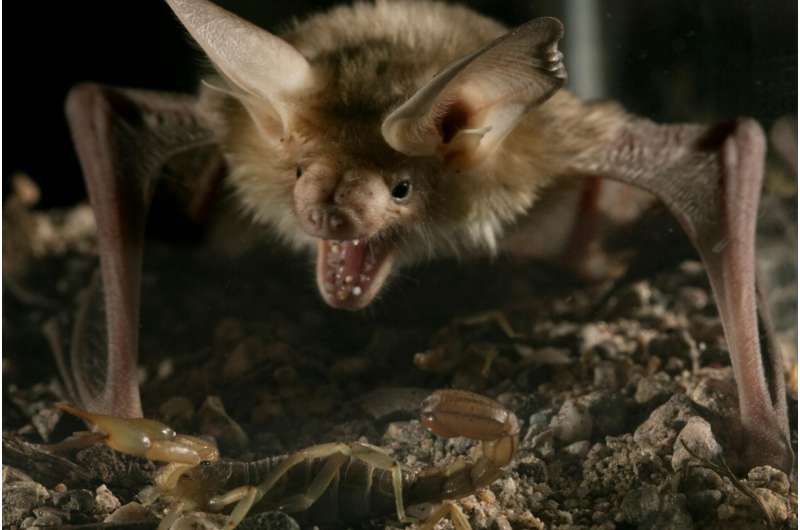Study finds pallid bat is unfazed by venom of Arizona bark scorpion

The Arizona bark scorpion is the most venomous scorpion in North America. It possesses venom that causes serious pain in humans and can kill a child if anti-venom is not administered quickly.
The pallid bat, a species that lives in a region ranging from southern British Columbia to central Mexico, is believed to be resistant to scorpion venom, but no laboratory studies have been performed to confirm this.
Researchers at the University of California, Riverside now report in a paper published online in PLOS ONE that the pallid bat hunts the Arizona bark scorpion but is unaffected by its venom even after it is stung multiple times during the hunt.
The study presents the first evidence that pallid bats are resistant to Arizona bark scorpion venom at concentrations that cause significant pain and death in mice.
"Even direct injection of venom in this bat in known doses has little effect on its behavior," said Khaleel A. Razak, Ph.D., an associate professor of psychology, who led the research project. "This suggests the evolution of mechanisms to modulate venom-induced pain in this bat species."
The pallid bat eats a variety of prey items: crickets, scorpions, centipedes, ground beetles, grasshoppers, cicadas, praying mantises, and long-horned beetles. They are also known to eat lizards and rodents. The species is a gleaning bat (meaning it plucks prey from leaves or the ground) and uses passive listening of prey-generated noise to localize and hunt terrestrial prey. This bat uses echolocation only for general orientation and obstacle avoidance.
Razak and his team had two main reasons for conducting the study on venom resistance: First, they wanted to identify mechanisms of pain modulation in the pallid bat. Second, they wanted to perform a comparison across animal species to understand different mechanisms of venom resistance. For example, the grasshopper mouse also has a mechanism of Arizona bark scorpion venom resistance.
The researchers used high-speed video in the lab to determine that the Arizona bark scorpion does indeed sting the pallid bat. Next, they injected a known concentration of the scorpion's venom directly into the pallid bat. They found the bat was resistant to the venom.
Razak and his team then performed an analysis of the dorsal root ganglia - clusters of nerve cell bodies in the dorsal root of spinal nerves - of the pallid bat and focused on "voltage gated sodium ion channels" which are present in pain receptors (or nociceptors). Pain signals are transduced into action potentials by pain receptors using these ion channels. Scorpion venom typically targets these ion channels.
The researchers identified amino acid substitutions in the voltage gated sodium ion channels in the dorsal root ganglia that may confer resistance to the venom. Specifically, they identified a few mutations in the channels that transduce pain signals.
"These mutations are novel in the pallid bat, suggesting an unknown mechanism of pain modulation in the pallid bat that involves altered ion channel function," said Bradley H. Hopp, a graduate student in Razak's lab and the first author of the research paper. He got interested in this research after identifying scorpion pieces in known pallid bat roosts. "Our work sets the stage to not only identify potentially novel mechanisms of pain modulation with application to human pain management but also increase our understanding of adaptive modifications of ion channel function that modulate the excitability of neurons."
The research team plans to test the function of mutations they found to help explain the mechanism by which pallid bats are immune to Arizona bark scorpion venom.
"We know that voltage gated sodium ion channels are important in generating the neural signals that we perceive as pain," Razak said. "We hope to identify the ways that the pallid bat has altered these channels to reduce pain, and to see if that process can be mimicked pharmacologically. We also want to study gleaning behavior from an evolutionary perspective. About 30 of the ~1200 species of bats use gleaning as their foraging strategy. But they come from different families of bats, which means gleaning—and potentially scorpion venom resistance in other bats—must have evolved in a convergent manner."
Razak, who began his career as an engineer in India, worked for a company that built ultrasound scanners to detect pregnancies. This got him interested in sonar, radar, and hearing. At the University of Wyoming, where he got his doctoral degree, he took an interest in biosonar, also known as echolocation—the production, reception, and analysis of sound waves for the purpose of locating objects. At UC Riverside, his lab mostly focuses on research questions relevant to the sense of hearing, including hearing in bats.
Journal information: PLoS ONE
Provided by University of California - Riverside


















